Kenneth L. Gentry Jr.'s Blog, page 39
February 18, 2022
RESURRECTION, PAUL, & ACTS 24:15 (1)
 PMW 2022-014 by Kenneth L. Gentry, Jr.
PMW 2022-014 by Kenneth L. Gentry, Jr.
Hyper-preterism may be a small movement, but it is a vociferous one. Hyper-preterists believe that the eschatological expectations in Scripture were all fulfilled in the destruction of the temple in AD 70 which closed the old covenant era. Though they are correct in noting the overlooked significance of AD 70, they are incorrect in applying all eschatology to that event.
One of their favorite passages is Acts 24:14–15. In this passage we come upon passage that is significant to the debate. There Paul writes:
But this I admit to you, that according to the Way which they call a sect I do serve the God of our fathers, believing everything that is in accordance with the Law and that is written in the Prophets; having a hope in God, which these men cherish themselves, that there shall certainly be a resurrection of both the righteous and the wicked.
This text is re-interpreted by Hyper-preterists in order to counter the historic Christian position on the resurrection. The evidence that the Hyper-preterist draws from this text is supposedly found in the Greek phrase that is here translated: “there shall certainly be a resurrection.” The Greek words behind this English translation are: anastasin mellein esesthai.
Hyper-preterism seizes upon the word mellein (from the Greek verb mello) and argues that it should be translated “about to.” That is, they would translate this phrase: “there is about to be a resurrection.” According to them, therefore, Paul is stating that he is expecting the resurrection to occur soon (i.e., at AD 70).
Have We Missed the Second Coming: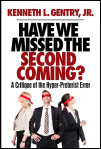
A Critique of the Hyper-preterist Error
by Ken Gentry
This book offers a brief introduction, summary, and critique of Hyper-preterism. Don’t let your church and Christian friends be blindfolded to this new error. To be forewarned is to be forearmed.
For more Christian educational materials: www.KennethGentry.com
Unfortunately for the Hyper-preterist, this is a misreading of Paul that they wrongly employ to support their theological error. In this two-part series on Acts 24:14–15 I will demonstrate the lexical, syntactical, and contextual errors inherent in the Hyper-preterist analysis. I will deal with the first of these in the current article, then the other two in the next one. So, let’s begin with the:
The lexical data
First, lexically the word mello has several possible meanings. That is, it does not simply mean “about to,” as the Hyper-preterist argument requires. Indeed, it is a rather ambiguous term. Greek scholar Daniel B. Wallace has written an important Greek grammar titled, Greek Grammar: Beyond the Basics: An Exegetical Syntax of the New Testament (1996). On p. 536 of this work he speaks of “the ambiguity of the lexical nuance of mello (which usually means either ‘I am about to’ [immediacy] or ‘I will inevitably’ [certainty]).”
This is widely recognized by lexicographers. For instance, the Exegetical Dictionary of the New Testament (2:404) declares: “Clearly … mello does not always have a fixed meaning.”
Below I will cite a few technical sources for the definition and explanation of mello. Please be aware: when I cite these lexical sources I will expand the abbreviated (space-saving) terms rather than encumber the reader with [bracketed] expansions. Other than this, the citations are exact.
The Baur-Arndt-Gingrich-Danker Lexicon exposes some of the ambiguity by offering the following definitions of mello:
“1. to take place a future point of time and so to be subsequent to another event, be about to, used with an infinitive following…. 2. to be inevitable, be destined, inevitable…. 3. The participle is used absolutely in the meaning (in the) future, to come…. 4. delay….”
In the Louw-Nida Greek-English Lexicon of the New Testament Based on Semantic Domains (vol. 1) we read the three leading meanings of mello:
“mello: to occur at a point of time in the future which is subsequent to another event and closely related to it — ‘to be about to.’” (p. 636)
“mello: to be inevitable, with respect to future development — ‘must be, has to be.’” (p. 672)
“mello: to extend time unduly, with the implications of lack of decision — ‘to wait, to delay.’” (p. 646).
In the Exegetical Dictionary of the New Testament (2:403) we read the following definitions: “intend, be about to, will (as auxiliary verb for the future), be destined to; consider, hesitate, delay.”
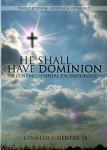
He Shall Have Dominion
(paperback by Kenneth Gentry)
A classic, thorough explanation and defense of postmillennialism (600+ pages). Complete with several chapters answering specific objections.
See more study materials at: www.KennethGentry.com
The ambiguity of mello is clearly seen in these lexical definitions. The term can even have opposite meanings, speaking either of a soon-coming event or a delay! It is not helpful to a new movement to base an important argument on the single appearance of an ambiguous verb in an attempt to overthrow 2000 years of Christian orthodoxy. This lexical evidence alone renders void this particular Hyper-preterist argument. But this evidence does not stand alone: there is more!
To be continued in the next article.
February 11, 2022
IS REVELATION PAST? (4)
 PMW 2022-013 by Kenneth L. Gentry, Jr.
PMW 2022-013 by Kenneth L. Gentry, Jr.
I am now drawing to the conclusion of my four-part series on the reasoning behind a preteristic understanding of Revelation. Many deem the great judgments and upheaval of Revelation as undermining the glorious postmillennial hope. This is mistaken in that the bulk of Revelation was fulfilled in the first century. As we have been seeing.
I am now ready for my concluding article with the: Thematic Indicators
As mentioned in previous articles, the theme of divine judgment on Israel fits perfectly with the Olivet Discourse. Virtually all commentators note the remarkable parallels between Matthew 24 and Revelation 6. These parallels are sufficient alone to suggest the same theme, but other correspondences exist.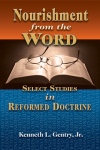
Nourishment from the Word
(by Ken Gentry)
Reformed studies covering baptism, creation, creeds, tongues, God’s law, apologetics, and Revelation
See more study materials at: www.KennethGentry.com
In Matthew 23 Christ scathingly denounces Israel’s leadership as he approaches the dramatic conclusion of his earthly ministry. He notes that Israel’s present failure is not an isolated event, but the culmination of a lengthy historical pattern — as do Stephen (Ac 7) and Paul (1Th 2:14-16). He concludes his rebuke with a prophecy that Israel will “fill up” (Mt 23:32) her guilt in “this generation” (23:36) when she “persecutes” those Jesus is “sending” (23:34; cp. Ac 8:1; 1Th 2:14-16).
Thereupon, Jesus weeps over Jerusalem (23:37), declares her temple “desolate” (23:38), and ceremoniously departs from it (24:1a). When the disciples express confusion at his rejection of the temple (24:1b), He prophesies its utter destruction (24:2). This specific prophecy prompts the disciples’s questions about the time of this judgment (24:3). Jesus responds with his Olivet Discourse. The first portion of the discourse (24:2-34) focuses particularly on the temple (Mt 24:2) in Judea (v. 16) during that “this generation” (v. 34),1 just as John’s Revelation focuses on the Jews (1:7; 2:9; 3:9) and the temple (11:1-8) in the near future (1:1, 3; 22:6, 10). As noted above, both John and Jesus merge Zechariah 12:10 and Daniel 7:13 in this context of approaching judgment upon Israel (Mt 24:30; Rev 1:7). Both prophecies warn of A.D. 70.[image error]For more information and to order click here.
" data-image-caption="" data-medium-file="https://postmillennialismtoday.files...." data-large-file="https://postmillennialismtoday.files...." class="alignright size-thumbnail wp-image-211" src="https://postmillennialismtoday.files...." alt="Perilous Times: A Study in Eschatological Evil" width="101" height="150">Perilous Times: A Study in Eschatological Evil (by Ken Gentry)
Technical studies on Daniel’s Seventy Weeks, the great tribulation, Paul’s Man of Sin, and John’s Revelation.
See more study materials at: www.KennethGentry.com
Furthermore, several other NT passages warn of the Jerusalem’s judgment in A.D. 70:
“Truly I say to you, there are some of those who are standing here who shall not taste death until they see the kingdom of God after it has come with power” (Mk 9:1).
“The Jews, who both killed the Lord Jesus and the prophets, and drove us out. They are not pleasing to God, but hostile to all men, hindering us from speaking to the Gentiles that they might be saved; with the result that they always fill up the measure of their sins. But wrath has come upon them to the utmost” (1Th 2:15-16).
“Not forsaking our own assembling together, as is the habit of some, but encouraging one another; and all the more, as you see the day drawing near” (Heb 10:25).
“You too be patient; strengthen your hearts, for the coming of the Lord is at hand” (Jas 5:8-9).
“The end of all things is at hand; therefore, be of sound judgment and sober spirit for the purpose of prayer” (1Pe 4:7).
This all fits well with an AD 70 focus. This all supports the preterist analysis of Revelation.
Click on the following images for more information on these studies:




February 10, 2022
REVELATION AS PAST TENSE (2)
 PMW 2022-011 by Kenneth L. Gentry, Jr.
PMW 2022-011 by Kenneth L. Gentry, Jr.
(NOTE: Oops! This should have been published on 2/4/22. But I accidentally saved this as a draft! Sorry about that. They say there are three signs of old age: (1) Memory Loss. Unfortunately, I can’t remember the other two. But enough about my failing memory.)
In my first article in this series I introduced the first of four arguments for approaching Revelation from the preterist perspective. The first article focused on the temporal indicators that John places in Revelation. Lexically, it is clear that he expected the events to “soon” take place (Rev 1:1) because “the time is near” (Rev 1:3).
But after placing that argument as the foundation stone for the preterist house, we need to notice that there are other indications as well. In this installment I will consider Audience Indicators. Revelation did not fall down out of heaven as book of concepts. It was given in a real, historical context. It is what scholars call, “occasional literature.” That is, it was written regarding a certain occasion, which I believe to be the fall of Jerusalem and the temple in AD 70.
John emphasizes the nearness of his prophetic events, in a way most relevant to his original recipients. In fact, to delay the prophetic events thousands of years would contradict his whole point in writing Revelation.
Navigating the Book of Revelation [image error]For more information and to order click here.
" data-image-caption="" data-medium-file="https://postmillennialismtoday.files...." data-large-file="https://postmillennialismtoday.files...." class="alignright size-thumbnail wp-image-209" src="https://postmillennialismtoday.files...." alt="Navigating the Book of Revelation: Special Studies on Important Issues" width="99" height="150" />(by Ken Gentry)
Technical studies on key issues in Revelation, including the seven-sealed scroll, the cast out temple, Jewish persecution of Christianity, the Babylonian Harlot, and more.
See more study materials at: www.KennethGentry.com
First, John writes to seven historical churches. Immediately after twice declaring the nearness of the events (1:1, 3) we read: “John to the seven churches that are in Asia” (1:4a). In 1:11 and 2:1–3:22 he specifically names the churches. John informs these first century churches of events ‘soon’ (1:1) to come to pass because “the time is near” (1:3). How could they have understood John to really mean that either 2,000 years would elapse before the events broke out or that they would drag on and repeat themselves for 2000 years?
Second, studies by William Ramsey and Colin Hermer show how intimately Revelation addresses those specific churches regarding their histories, settings, and struggles. The seven letters are occasional letters designed specifically for their concerns.
Third, within these letters we also find temporal qualifiers suggesting those churches would experience the shock waves from the events of Revelation (2:5; 2:16; 3:11; 22:12, 20). One of them was “about to” be tried by Satan (2:10; cp. 1:19 Gk.). To another Christ is “coming quickly” in judgment (2:16; cp. 1:1). To still another He promises: “I also will keep you from the hour of testing, that hour which is about to come upon the whole world [oikumene]” (3:10; cp. 1:19 Gk.). Indeed, a church must “hold fast” for awhile in that Christ’s judgment-coming will trans transpire “quickly” (3:11; cp. 1:1).
Survey of the Book of Revelation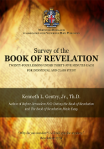
(DVDs by Ken Gentry)
Twenty-four careful, down-to-earth lectures provide a basic introduction to and survey of the entire Book of Revelation. Professionally produced lectures of 30-35 minutes length.
See more study materials at: www.KennethGentry.com
Fourth, John wrote Revelation while these churches were enduring stressful times: “I, John, your brother and fellow partaker in the tribulation and kingdom and perseverance which are in Jesus” (1:9a). Revelation promises quickly to vindicate the martyrs who cry: “How long?” (6:9). The were told “they should rest for a little while longer” (6:10-11; cp. Lk 18:7-8). In fact, later in Revelation, we learn “there shall be delay no longer” (10:6). Yet, on the non-preterist interpretation, their vindication was not after “a little while,” and the events await an enormous delay.
And there is more! But you will have to wait for the next article in this series.
February 8, 2022
REVELATION AS PAST TENSE (3)
 PMW 2022-012 by Kenneth L. Gentry, Jr.
PMW 2022-012 by Kenneth L. Gentry, Jr.
This is my third installment on the question of the evidence that Revelation was fulfilled in the first century. As surprising as this conclusion is for the modern evangelical, the proof is in Revelation itself. In this article I will consider the Historical Indicators for preterism.
I agree with the Puritan Talmudic scholar, John Lightfoot: Revelation appears to prophesy Christ’s judgment upon the Jews in A.D. 70. John’s opening statement of purpose (1:7), the seven letters (2:9; 3:9), and the body of Revelation (4-19; e.g., 7:1-8; 11:1-8) all reflect this truth.
Just after mentioning the nearness of the events (1:1, 3) and just before alluding to the dire circumstances of his original audience (1:9), verse 7 warns: “Behold he comes with the clouds, and will see him every eye and those who him pierced, and will wail over him all the tribes of the land. Yes, amen” (Alfred Marshall, The Interlinear Greek-English NT; cp. Robert Young, Literal Translation). Though this sounds like a Second Advent reference, the following evidence points to A.D. 70.
Coming with the Clouds
Cloud-coming language often speaks of historical divine judgments. For instance, Isaiah 19:1a warns: “An oracle concerning Egypt: See, the LORD rides on a swift cloud and is coming to Egypt” (cp. Ps 18:7-15; 104:3; Joel 2:1,2; Na 1:2ff.; Zep 1:14,15). This speaks of the Assyrian king Esarhaddon conquering Egypt in 671 B.C. As Young notes: “The scene does not necessarily suggest that the Lord comes from the Temple at Jerusalem nor from heaven, but merely that He comes as a judge” (Isaiah, 2:14), i.e., providentially, not personally.
Interestingly, John follows Jesus in merging Zechariah 12:10 and Daniel 7:13. Like John, Jesus mentions the “coming on the clouds” (cp. Mt 24:29-30) against Israel (Mt 23:36-24:2, 16). And like John, Jesus ties the events to the near future: “all these things shall come upon this generation” (Mt 24:34).
Great Tribulation: Past or Future?
(Thomas Ice v. Ken Gentry)
Debate book on the nature and timing of the great tribulation. Both sides thoroughly cover the evidence they deem necessary, then interact with each other.
See more study materials at: www.KennethGentry.com
Those Who Crucified Christ
Christ’s judgment-coming is against: “they who pierced him.” Jesus blames the Jews for his death: “Christ began to show His disciples that He must go to Jerusalem, and suffer many things from the elders and chief priests and scribes, and be killed” (Mt 16:21; cp. Mt 20:18-19; 21:33-43; Mk 8:31; Lk 9:22). The apostles also lay the covenantal blame for his crucifixion upon Israel: “Then know this, you and all the people of Israel: It is by the name of Jesus Christ of Nazareth, whom you crucified” (Ac 4:10a; cp. Jn 19:5-15; Ac 2:22, 23, 36; 3:14, 15; 4:8-10; 5:30; 10:39; 1Th 2:14-16). Revelation 1:7 must refer to the first century in that those who “pierced him” are now long since deceased.
The Tribes of the Land
This judgment brings mourning upon “all the tribes of the land” (1:7; Marshall’s Interlinear). These “tribes” (phyle) must be the tribes of Israel (cf. Mt 19:28; Lk 22:30). TDNT notes that the Septuagint “with few exceptions . . . has phyle, so that this becomes a fixed term for the tribal system of Israel” (9:246). Revelation clearly mentions those Jews who were saved out from “the tribes” of Israel (7:4-8; cp. 21:12); and John sets these over against other “tribes and peoples” beyond Israel (7:9; cp. 11:9).
What is more, John associates these “tribes” with “the land” (tes ges), the well-known Promised Land (cp. Lk 21:23). As Edersheim observes: “Palestine was to the Rabbis simply ‘the land,’ all other countries being summed up under the designation of outside the land.”1 Indeed, the OT mentions “the tribes” and “the land” together in numerous instances (e.g., Ge 49:16; Nu 26:55; Jos 14:1; 19:51; Eze 45:8; 48:29).
Kids Who Kill
(by Gov. Mike Huckabee)
Proposes a key to recovering our country’s basic values: faith, family, work, and community.
See more study materials at: www.KennethGentry.com
In the seven letters John specifically mentions the defection of the Jews from God. He even informs the churches that Christ will vindicate them by judging the Jews:
• “I know your tribulation and your poverty (but you are rich), and the blasphemy by those who say they are Jews and are not, but are a synagogue of Satan.(2:9)
• Behold, I will cause those of the synagogue of Satan, who say that they are Jews, and are not, but lie, behold, I will make them to come and bow down at your feet, and to know that I have loved you.” (3:9)2
Surely this humiliation of the Jews was in the lifetime of the recipients of Revelation — in A.D. 70 when the Jews were “cast out” (Mt 8:10-12) and the kingdom was given to the gentiles (Mt 21:40-43).
The Temple and Holy City
Revelation expressly mentions the coming destruction of the temple, and with language drawn from the Olivet Discourse.
“Jerusalem will be trampled on by the Gentiles until the times of the Gentiles are fulfilled” (Lk 21:24b).
“But exclude the outer court; do not measure it, because it has been given to the Gentiles. They will trample on the holy city for 42 months” (Rev 11:2).
Note that both of these passages inform us that the “holy city/Jerusalem” will be “trampled” by the “gentiles.” And both appear in prophecies confined to the short term (1:1, 3; 22:6, 10; Lk 21:31-32). Evidently, these texts are referring to the same events, with John deriving his cue from Christ’s discourse about A.D. 70 (Lk 21:6-7).
Interestingly, the time of the formal imperial engagement of the Jewish War until the destruction of the temple was forty-two months. According to Bruce, after the initial Jewish uprising in A.D. 66, Vespasian “arrived the following spring [A.D. 67] to take charge of operations. . . . Titus began the siege of Jerusalem in April, 70. The defenders held out desperately for five months, but by the end of August, the Temple area was occupied and the holy house burned down, and by the end of September all resistance in the city had come to an end.”3 From Spring A.D. 67 to September A.D. 70, covers a period right at forty-two months. This is a remarkable correspondence which fits relevantly with all the other data.
And now: three down, one more to go! My next article will conclude this series.
February 4, 2022
REVELATION AS PAST TENSE (1)
 PMW 2022-010 by Kenneth L. Gentry, Jr.
PMW 2022-010 by Kenneth L. Gentry, Jr.
Due to the widespread influence of dispensationalism, the preterist approach to Revelation shocks many Christians. So it is important to carefully introduce them to the exegetical rationale for this approach.
I believe we should present a four-fold exegetical justification for preterism in Revelation. These justifications are rooted in interpretive demands derived from the text itself, not from theological predispositions (e.g., anti-premillennialism) or from traditional predilections (e.g., Moses Stuart, Milton Terry).
So I will begin with in this first article with: Temporal Indicators.
The leading preterist evidence derives from John’s temporal delimitations, which he emphasizes by strategic placement, didactic assertion, frequent repetition, and careful variation.
Blessed Is He Who Reads: A Primer on the Book of Revelation
By Larry E. Ball
A basic survey of Revelation from the preterist perspective. It sees John as focusing on the destruction of Jerusalem and the temple in AD 70.
See more study materials at: www.KennethGentry.com
He strategically places them twice in his introduction (1:1, 3) and five times in his conclusion (22:6, 7, 10, 12, 20), thereby bracketing the highly wrought drama within (4:1–22:6). In these didactic passages John employs two terms demanding preterism: tachos / tachu (1:1, cp. 22:7, 12, 20) and eggus (1:3; cp. 22:10). For example:
The Revelation of Jesus Christ, which God gave Him to show to His bond-servants, the things which must shortly [tachos] take place. . . . Blessed is he who reads and those who hear the words of the prophecy, and heed the things which are written in it; for the time is near [eggus]. (1:1a, 3)
John immediately impresses upon his reader the nearness of his prophetic events.
Lexicographers agree on the temporal significance of tachos in Revelation: The Baur-Arndt-Gingrich-Danker Lexicon (BAGD) notes that en tachei means: “soon, in a short time Lk 18:8; Ro 16:20; 1 Ti 3:14 v.1; Rv 1:1; 22:6; 1 Cl 65:1; shortly Ac 25:4.” Thayer offers the following range of meanings: “quickness, speed and quickly, shortly, speedily, soon,” listing Revelation 1:1 and 22:6 with the “speedily, soon” entries. Abbott-Smith concurs: 1:1 and 22:6 mean “quickly, speedily, soon.”
Greek text editors F. J. A. Hort, Kurt Aland, and Howard Marshall agree. Hort translates it “shortly, soon.” Aland comments: “In the original text, the Greek work used is tachu, and this does not mean ‘soon,’ in the sense of ‘sometime,’ but rather ‘now,’ immediately.” Marshall cites Revelation 1:1 and 22:6 as evidence that the normal use of the phrase en tachei “suggest[s] that soon is the meaning.”
In fact, all English versions translate it either as: “soon” (NIV, RSV, Beck, NRSV, NAB, CEV), “shortly” (KJV, ASV, Weymouth, NEB, NASB, NKJV), or “very soon” (Moffatt, Phillips, Williams, TEV). Tachos obviously indicates temporal brevity elsewhere (e.g., Lk 18:8; Ac 12:7; Ro 16:20). The same is true of its related form tachus (Mt 5:25; Mk 9:39; Lk 15:22; cp. Rev 2:16; 3:11; 11:14; 22:7, 12, 20).
Book of Revelation Made Easy
(by Ken Gentry)
Helpful introduction to Revelation presenting keys for interpreting. Also provides studies of basic issues in Revelation’s story-line.|
See more study materials at: www.KennethGentry.com
This evidence is reinforced by John’s linking tachos with eggus in the same contexts, as if to provide a two-fold witness (1:1, 3; 22:6, 10). BAGD provides the following entry for eggus: “of time near a. of the future: kairos Mt 26:18; Rv 1:3; 22:10.” The other lexicons cited above concur. TDNT notes that the term means “temporally near at hand” and observes that “like the Synpt., Rev. uses eggus only as a term for the near coming of the kingdom of God. Thus we have ho gar kairos eggus in 1:3; cf. 22:10″ (3:330, 331). The various samples of eggus in the NT all agree: some relating spatial, others temporal nearness (Mt 24:32, 33; 26:18; 13:28, 29; Lk 19:11; 21:30, 31). And again, all translations of Revelation agree; all versions cited above have either “near” or “at hand.”
Perhaps the most interesting proof of the meaning of these terms is the various competing, innovative, counter-intuitive attempts to get around their obvious significance! Indeed, if these terms do not express temporal nearness, what terms could John have used to do so? I am firmly convinced John prophesies the fast approaching destruction of the Temple in A.D. 70.
But there is more. I will engage the second line of evidence in my next article.
Click on the following images for more information on these studies:


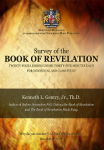
February 1, 2022
IS ORTHODOX PRETERISM RE-BRANDED FUTURISM?

PMW 2022-009 by Kenneth L. Gentry, Jr.
In the last thirty years or so the Hyper-preterist movement has made its presence felt in dozens of evangelical churches. But it is has developed an especially strong Internet presence that has been able to attract hundreds of theological enthusiasts. In fact, it is largely through its Internet presence that it has been able to grow in numbers, spread in geography, and infiltrate in churches.
Hyper-preterism (or Full Preterism or Consistent Preterism or Covenant Eschatology, as it is known by its adherents), is an extension of preterism. But it is an extension that has pushed its theology beyond biblical limits.
Preterism holds that there are a number of passages in the NT that refer to the destruction of Jerusalem, even though many Christians have viewed these as referring to the time of the second advent. Preterists derive this understanding from the express statements of Scripture, statements declaring that the events will occur in “this generation,” because “the time is near,” “soon,” and so forth.
Keys to the Book of Revelation
(DVDs by Ken Gentry)
Provides the necessary keys for opening Revelation to a deeper and clearer understanding.
See more study materials at: www.KennethGentry.com
Hyper-preterism, though, uses these passages as a leaping-off point, building its innovative theology on these passages and applying temporal limitations where they do not appear. They believe that all Bible prophecy was fulfilled by AD 70. They hold that the time of the AD 70 destruction of the temple experienced the second coming of Christ, the great judgment, the resurrection of the dead, and more.
By departing from the universal, historic, formal, corporate, public, systematic belief of the Christian faith in these areas, Hyper-preterism has constructed a new, aberrant theology. Hyper-preterists have radically reworked the Christian doctrinal system and overthrown the faith once for all delivered to the saints.
Interestingly, Hyper-preterists are so enamored with their system that they like to use the word “futurism” as a pejorative put-down for historic, orthodox preterists. That is, since orthodox preterism holds to a future second coming, bodily resurrection, and final judgment, Hyper-preterists loudly declaim it as actually being a futurist system.
This charge of futurism is erroneous on two counts.
First, “futurism” is a widely-used, well-known term that has historically spoken of a specific eschatological commitment to a future, literal establishment of the millennial reign of Christ. Futurism has for a long time been defined by noted Christian theologians. It has not been left to the Hyper-preterist movement to define. Their employment of this term as a put-down for orthodox preterists is uncalled for.
And if it were legitimate to deride orthodox preterists as “futurists” because they accept future elements in their eschatology, then it ought to be the case that dispensationalist futurists ought to be called “preterists” because they recognize certain prophecies were preteristically fulfilled in AD 70. For instance, they understand that Luke 21:20–24 prophetically points to AD 70.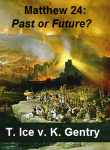
Matthew 24 Debate: Past or Future?
(DVD by Ken Gentry and Thomas Ice)
Two hour public debate between Ken Gentry and Thomas Ice on the Olivet Discourse.
See more study materials at: www.KennethGentry.com
Second, interestingly one of the most important Hyper-preterists was J. Stuart Russell (1816–1895). His large and impressive work The Parousia (1887) was resurrected (!) in 1987 by Baker Book House and has been a standard text of the Hyper-preterist movement that developed after its republication. And Russell is clearly a Hyper-preterist (a modern designation) in that he held to the key commitments of this new movement: the AD 70 destruction of the temple witnessed the second coming of Christ, the great judgment, and the resurrection of the dead.
Nevertheless, in this primary document of the Hyper-preterist movement we discover “futurist” elements by this champion of preterism (i.e., Hyper-preterism). Let me demonstrate this.
In speaking of the loosing of Satan (Rev 20:7–10), Russell writes:
“It is evident that the prediction of what is to take place at the close of a thousand years does not come within what we have ventured to call ‘apocalyptic limits.’ These limits, as we are again and again warned in the book itself, are rigidly confined within a very narrow compass; the things show are ‘shortly to come to pass.’ It would have been an abuse of language to say that events at the distance of a thousand years were to come to pass shortly; we are therefore compelled to regard this prediction as lying outside the apocalyptic limits altogether.” (Parousia, 522).
He continues in the next paragraph: “We must consequently regard this prediction of the loosing of Satan, and the events which follow, as still future and therefore unfulfilled.” On the next page (p. 523) he adds: “This we believe to be the sole instance in the whole book of an excursion into distant futurist; and we are disposed to regard the whole parenthesis as relating to matters still future and unfulfilled.”
Then as he closes his book, he declares very clearly his postmillennial hope for the conversion of the world — an unfulfilled prophetic hope. Speaking of statements by the apostle Paul, Russell (pp. 553, 554) notes:
“He does not hesitate to affirm that the restorative work of Christ will ultimately more than repair the ruin wrought by sin…. We are happy to be assured of the consummation on higher and safer grounds, even the promises of Him who has taught us to pray, ‘Thy will be done in earth, as it is done in heaven.’ For every God-taught prayer contains a prophecy, and conveys a promise. This world belongs no more to the devil, but to God. Christ has redeemed it, and will recover it, and draw all men unto Him. Otherwise it is inconceivable that God would have taught His people in all ages to utter in faith and hope that sublime prophetic prayer: — “God be merciful unto us, and bless us; And cause his face to shine upon us; They thy way may be known upon earth, Thy saving health among all nations. … And all the ends of the earth shall fear him.’”
Here he is citing from Psalm 67.
Should Russell should then be written-off as an futurist?
Click on the following images for more information on these studies:

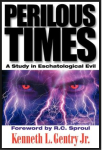

January 28, 2022
THE FINAL RESURRECTION (3)
 PMW 2022-008 by Kenneth L. Gentry, Jr.
PMW 2022-008 by Kenneth L. Gentry, Jr.
In this article I am concluding a three-part series on our resurrection as taught by Paul in 1 Cor 15. This continues the previous presentation outlining Paul’s second argument in his great resurrection chapter. The other two articles need to be consulted before jumping into this one. Unless you are good at back masking, and you can hum well..
(3) Paul’s parallels and contrasts show his concern is not physical v. immaterial, but perishable v. imperishable (v. 42), dishonor v. honor (v. 43a), and weakness v. power (v. 43b). Our resurrected condition is so governed by the Holy Spirit that the weaknesses of our present condition will be totally overcome by the transformational power of the Spirit. Indeed, he emphasizes the difference of glory as the key (vv. 40-41).
(4) According to scholars such as A. T. Robertson, generally adjectives ending in –inos denote compositional material, whereas those ending with –ikos signify characteristics. This fits the flow of Paul’s argument regarding the “natural”(psuchikos) and the “spiritual” (pneumatikos) body as I have presented it — and it supports the historic faith of the Church regarding the resurrection.
KEYS TO THE BOOK OF REVELATION (DVD lectures)
By Ken Gentry
These four lectures provide the necessary keys for opening Revelation to a deeper and clearer understanding. Excellent for individual or group studies.
See more study materials at: www.KennethGentry.com
(5) Once again Paul brings in the parallel between Adam and Christ as illustrating the differing circumstances of our estates (vv. 45-48). In verse 45 he applies Genesis 2:7 in light of his resurrection argument, contrasting the Adamic condition (the first Adam) with the resurrected Christ (the second Adam). (He cites the LXX: “the man became a living [psuchen] soul.”) Adam’s body was a psuchen body subject to animal weaknesses (hunger, death, and so forth, Gen. 1:29; 2:17). Once again we have the distinction between the psuche (soul) and pneuma (spirit): But we know that Adam was not immaterial, nor was Christ in his resurrection. The idea here is that just as Adam is the source of our perishable bodies as the “first Adam,” so Christ is the source of our Spirit-powered bodies as the “last Adam” (the man of the last estate or condition of the redeemed). Thus, Paul is drawing the parallel between the two material bodies and their consequent conditions (cp. v. 22), then noting the superiority of the consummate state represented in Christ’s resurrection condition.
(6) In verse 47 (“the first man is from the earth, earthy; the second man is from heaven”) Paul is not speaking of the origin of Adam and of Christ, but the quality of their conditions (focusing on the resurrected Christ). He is reiterating the difference between their weakness/power, inglorious/glorious conditions. Resurrected believers share the heavenly life of Christ but are not from heaven themselves. Paul contrasts the resurrection body with the Genesis 2:7 Adam (vv. 45-46). Thus, “just as we have borne the image of the earthy, we shall also bear the image of the heavenly” (v. 49). We shall wear the image of the heavenly Second Adam, whatever his resurrection was like.
(7) In verse 50 he contrasts man’s fallen condition with his eternal condition in Christ: “Now I say this, brethren, that flesh and blood cannot inherit the kingdom of God; nor does the perishable inherit the imperishable.” The phrase “flesh and blood” shows the need for transformation. It highlights the weakened, sinful estate, not the material condition. In the LXX “flesh and blood” stands for human weakness as subject to and indicative of death (cf. Deut. 32:42; Isa. 49:26; Jer. 51:35; Eze. 39:17-18; Zeph. 1:17). Therefore, “flesh and blood” parallels with the decayed realm, for “this perishable must put on the imperishable, and this mortal must put on immortality” (v. 53) Paul uses touto (“this”) four times: twice in 53 and twice in 54. His use of “this” demands continuity of the body (this body) even during transformation to the resurrected estate.
MATTHEW 24 DEBATE: PAST OR FUTURE?
Thomas Ice and Kenneth Gentry
Two hour formal, public debate between Ken Gentry and Thomas Ice on the Olivet Discourse. Pits orthodox preterism against revised dispensationalism.
See more study materials at: www.KennethGentry.com
Conclusion
When all is said and done, the historic position of orthodox Christianity is sustained. Christ was physically resurrected (though with transformed powers) and so shall we be. God created man as distinct from angels. We are designed to be physical creatures for: (1) God sovereignly and purposely created the objective, material world in which we live (Gen 1; Psa 33:6-11). (2) He lovingly and carefully formed our physical bodies for dwelling in this material world (Gen 2:7-24) which he has entrusted to man (Psa 8:1-9; 115:16). (3) He brought his objective, propositional revelation to us through the historical process of inspiration and inscripturation by means of men moved by the Spirit of God (2 Tim 3:16-17; 2 Pet 1:20-21). (4) In the Second Person of the Trinity, God took upon himself a true human body and soul (which he still possesses, Col 2:9) and entered history for the purpose of redeeming men back to a right relationship with him (Rom 1:3; 9:5; Heb 2:14). (5) His elect people will inherit the eternal estate in resurrected, physical bodies (John 5:28-29; 1 Cor 15:20-28) so that we might dwell in a material New Creation order (2 Pet 3:8-13).
January 25, 2022
THE FINAL RESURRECTION (2)
PMW 2022-007 by Kenneth L. Gentry, Jr.
This is the second of three articles on our eschatological resurrection as understood in the postmillennial system. For Paul, Christ’s resurrection was a non-negotiable. And it was also the key to our own future resurrection. As I continue the previous study we come now to:
Paul’s First Argument
After insisting that Christ was resurrected from the dead and that this is the foundation of our redemptive hope (vv. 1-19), Paul then powerfully links our resurrection to Christ’s. In other words, his whole point regarding Christ’s resurrection is to lay a foundation for ours. In verse 20 we read: “But now Christ has been raised from the dead, the first-fruits (Gk., aparche) of those who are asleep.” This first-fruits imagery carries a load of theological implications regarding our physical resurrection.
First, the temporal significance of “first” requires that Christ’s resurrection is peculiarly the first of its kind. No other consummate-order resurrection occurred previously. Second, in that he is the “first-fruit” he represents the rest, just as the Old Testament offering of the first part of the harvest represented the whole harvest (cp. Rom. 11:16). Christ’s resurrection represents our own. Third, the “first-fruit” also promises more to come. Christ’s was unique for the time, but it spoke of others to follow at “the end” (v. 24). Thus, the resurrection of Christ as the first-fruits is: (1) the first of this order to occur, (2) represents his people’s resurrection, and (3) expects more eschatological resurrections to follow at the end.
_______________________________________________________________________________
BEAST OF REVELATION: IDENTIFIED
By Ken Gentry
A popularly compiled presentation that serves as an antidote to dispensational sensationalism and newspaper exegesis. Convincing biblical and historical evidence showing that the Beast was the Roman Emperor Nero Caesar, the first civil persecutor of the Church. The second half of the book shows Revelation’s date of writing, proving its composition as prior to the Fall of Jerusalem in A.D. 70. A thought-provoking treatment of a fascinating and confusing topic.
For more study materials, go to: www.kennethgentry.com
Consequently, the fact of Christ’s resurrection is essential to the believer’s resurrection — and anticipates it. From Adam death arose and all of its processes; so from Christ life arises and its fullest blessings (vv. 21-28). The resurrection of Christ is necessary for the triumph of life over death (vv. 25-26), which will finally and fully be enjoyed only when we ourselves are raised from the dead and the “last enemy” is defeated (v. 26). It is fundamentally important to Paul.
In verses 29-34 Paul presents a relentless and vigorous ad hominem against his Corinthian opponents: He notes he is risking his life for what the Corinthians deny (v. 30-32). He lashes out against their spiritual pride in thinking they have arrived at the fullness of Holy Spirit blessings (v. 33). He warns that their “bad company” on this matter has “corrupted good morals” (v. 33; cp. 1 Cor. 6-7 particularly). They must become “sober” and “stop sinning” in this (v. 34). And all of this in the context of his argument for the resurrection of believers!
Thus, once we determine the nature of Christ’s resurrection, we understand the nature of our own. If Christ was physically raised from the dead, then so shall we, for he is the “first-fruits” of our resurrection. The only way around our physical resurrection is to deny Christ’s physical resurrection.
Paul’s Second Argument
Paul finally arrives at the specific objection toward which he has been driving: “But someone will say, ‘How are the dead raised? And with what kind of body do they come?'” (v. 35). Here he is clearly speaking of a physical resurrection in that: (1) His opening question concerns how the “dead” are “raised,” that is, “with what kind of body“? (2) The verb “raised” is attached to “the dead” in verses 1-34, and to their actual “bodies” in verses 35-58. And since he is dealing with their objection regarding a physical resurrection he now emphasizes the “body” (soma) in this portion of his argument (vv. 35, 37, 38, 40, 42, 44). (3) Christ’s resurrection from “the dead” is the key to the whole passage and argument (vv. 12, 13, 15-16), and his was a physical resurrection. In fact, Christ’s resurrection is mentioned in the context of his being “dead,” “buried,” and “raised.” Christ’s body was buried; so his body is what raised.
Contrary to their quasi-gnostic, hyper-spiritual, eschatologically-conditioned claims, Paul establishes the death of the body as the pre-condition for the fullness of the life they presently claim. He illustrates this by the seed that is sown, which must “die” (vv. 36-37) so that it can be raised to eschatological glory. Despite their pride of “having arrived,” the pneumatic Christians cannot “be there” yet. Their bodies haven’t been “sown.”
In verses 38-41 Paul emphasizes two crucial truths in response to their question (v. 35): (1) “God gives it a body just as he wished” (v. 38a). As with Augustine later, all objectors must recognize: “Is he who was able to make you when you did not exist not able to make over what you once were?” (Sermons on Ascension, 264:6). Any objection regarding the difficulty of resurrecting a dead body is more than accounted for by the fact that it is God who effects it.
(2) God gives bodies appropriate to their environment (v. 38b). He gives fish bodies appropriate to water, birds appropriate to flight, and so on (vv. 39-41). And all bodies have a level of “glory” appropriate to their estate (v. 40-41), whether they be “earthly” or “heavenly” (v. 40). The glorious condition of the resurrected body is adapted for victory over the decay element. Though our pre-eschatological condition suffers dishonor and weakness, our future estate will enjoy glory and power (vv. 43-44; cp. Rom. 8:11; 2 Cor. 4:7-12; Phil. 3:21). In fact, it is “the body” itself that will be transformed from being perishable to imperishable (vv. 42, 52-54).
_________________________________________________________________________________
THE CLIMAX OF THE BOOK OF REVELATION (DVDs)
By Ken Gentry
Six lectures on six DVDs that introduce Revelation as a whole, then focuses on its glorious conclusion. Provides an important, lengthy Introduction to Revelation also.
See more study materials at: www.KennethGentry.com
Paul employs shock therapy against these pneumatics: “It is sown a natural body, it is raised a spiritual body. If there is a natural body, there is also a spiritual body” (1 Cor. 15:44). His point appears to be that not only should they not denigrate the present material order (which they have done, chs. 6-7), but he informs them that they will be resurrected in a “spiritual body” in the eschatological order! And here is where the Hyper-Preterist theological naivete causes them to stumble so badly. Hyper-Preterists believe Paul’s reference to the “spiritual body” speaks of the substance of the body, its compositional makeup. Consequently, they are emboldened to employ this verse for discounting a physical resurrection. Of course, this is as wrong-headed as to say a Coca-Cola bottle is made of Coca-Cola. Note the following evidences supporting the orthodox approach to Paul’s argument (to name but a few):
(1) This “spiritual (pneumatikos) body” is no more immaterial than the “natural (psuchikos) body,” even though both “spirit” (pneuma) and “soul” (psuche) often refer to the immaterial element within the creature. Here Paul uses these (usually spiritual) terms to describe the body, and we know that our present natural (psuchikos) body is material. In 1 Corinthians 2:14 these adjectives distinguish the believer and the unbeliever. Rather than distinguishing their body materials, the terms focus on their driving forces: spiritual (Holy Spirit driven) concerns over against animal appetites
(2) In Paul the semantic domain for pneuma overwhelming means “pertaining to the Holy Spirit” (e.g., 1 Cor. 2:13; 3:1; 12:1; Rom. 1:11; Eph. 1:3; 5:19). That is, governed by the Spirit of God. The adjectives psuchikos and pneumatikos describe, therefore, the essential governing characteristic of each body: the present, unresurrected, fallen body over against the future, resurrected, redeemed body. That is, they speak of the earth-related, animal-appetite-controlled condition of the present order (the totality of man in his earthly estate) over against the eternity-related, Holy Spirit-controlled condition of the resurrected estate (the totality of man in his eternal estate). The glory of the eschatological state entered into by the eschatological resurrection involves the full dominance of the Holy Spirit and all that that entails (including the body’s imperishable condition and its moral control). And contextually, Paul designs his response to confront the prideful Corinthian pneumatics who think they have arrived at full spiritual glory. (Later Paul will note that the natural is first, not the spiritual, showing that the Corinthians must first live out their present lives before attaining the fullness of the Spirit, v. 46).
(To be continued).
January 21, 2022
THE FINAL RESURRECTION (1)
PMW 2022-006 by Kenneth L. Gentry, Jr.
As Christians we recognize the resurrection of Christ as of enormous significance in the Christian worldview. Paul dogmatically states: “if Christ has not been raised, your faith is worthless; you are still in your sins” (1 Cor 15:17). Clearly for him, Christ’s resurrection is foundational to our hope of salvation.
In this article I will deal with just one of the redemptive-historical effects of Christ’s resurrection: the eschatological resurrection of believers. Christ’s resurrection not only secures our present redemption for glory (Rom. 4:25; 10:9-10) but our future resurrection to glory (Rom.8:23).
Unfortunately, a new gnosticism is infecting the church: Hyper-preterism. One major feature of Hyper-Preterism is its denial of a future physical resurrection of the believer at the end of history. As we shall see, this contradicts a major result of the resurrection of Christ. Before I demonstrate this, I must briefly summarize the argument for Christ’s physical resurrection, which is the effective cause of our own future resurrection.
The Scriptures teach that Christ was resurrected in the same body in which he died: The very body in which he died was raised from the dead, just as he prophesied (John 2:18-19, 21). As such, it miraculously attested to the truth of his divine mission on earth (Matt. 12:39-40). This is why the tomb and his burial clothing were found empty: His physical body had departed from them (Matt. 28:6; John 20:4-11, 15). The gospels present the resurrected Christ in a material body that could be touched and handled (Luke 24:39), which still had the wounds of the cross (John 20:27; cf. Rev. 5:6), which could be clung to (John 20:17; Matt. 28:9), and could eat food (Luke 24:42-43; John 21:11-14). Christianity has always affirmed the corporeal resurrection of Christ as a prominent feature of its high supernaturalism.
__________________________________________________________________________________________
WHEN SHALL THESE THINGS BE?
(ed. by Keith Mathison)
This is a Reformed response to the aberrant HyperPreterist theology. Gentry’s chapter critiques HyperPreterism from an historical and creedal perspective.
See more study materials at: www.KennethGentry.com
But how does that speak to the issue of our resurrection? In that my space is limited I will simply provide an abbreviated commentary on 1 Corinthians 15 which speaks directly to the point and is a favorite passage for Hyper-Preterists. They gleefully point out that Paul speaks of a “spiritual body” (v. 44) and argues that “you do not sow the body which is to be” (v. 37).
The Corinthian Context and Problem
Before surveying this chapter we must be aware of a major underlying problem in this church located in the Greek city of Corinth: A mixture of a quasi-gnostic philosophy (highlighting higher knowledge and denigrating the physical realm) and an exorbitant pride rooted in pneumatic-eschatological claims.
Indeed, Paul opens his letter by referring to their pneumatic gifts (1:7; cp. chs. 12-14) and the matter of a Greek concern for “knowledge” (1:18-25; cp. chs. 2-4, 8-10). These issues almost invariably lie behind the particular problems he addresses. For example, their sexual immorality was rooted in their unconcern with issues of physical morality (1 Cor. 6:13, 15; “the body doesn’t matter! what’s the problem?”) and their denial of legitimate sexual relations in marriage (1 Cor. 7:1-4; ” we are above physical relations”). And their charismatic abuses are quite well-known (1 Cor. 12-14). They even revolted against local social conventions and boundary markers in disregarding public decorum in dress (hair style) by their “eschatological women” (1 Cor. 11; see Gordon Fee’s commentary). These women asserted that since the eschaton has come, then the resurrection is past — consequently, they are like the angels in heaven who have no need of marriage nor differentiation from males (based on Matt. 22:30).
Fortunately, Hyper-Preterists do not promote immorality, yet their doctrinal outlook has remarkable parallels to the Corinthian paradigm. But I must move quickly to the problem at hand, showing that Hyper-Preterism strikes at the vitals of our holy faith through flawed exegesis.
Introducing the Problem and the Solution
In 1 Corinthians 15 Paul focuses on a denial of the resurrection of the body. In the first part of his argument for the resurrection (vv. 1-34) he repeatedly expresses his concern for its necessity: “if the dead are not raised” (15:12, 13, 15, 16, 29, 32). To dispel all doubt about our resurrection he links Christ’s resurrection to ours (as elsewhere: Rom. 8:1; 1 Cor. 6:14; Phil. 3:21). As we will see, this linkage powerfully affirms the physical resurrection.
___________________________________
WHY I LEFT FULL-PRETERISM
by Samuel M. Frost
Former leader in Full Preterist movement, Samuel M. Frost, gives his testimony and theological reasoning as to why he left the heretical movement. Good warning to others tempted to leave orthodox Christianity.
See more study materials at: www.KennethGentry.com
___________________________________
In the second part of his response (vv. 35-57) Paul adapts his argument for the resurrection to the pneumatic-eschatological theology of his audience. He rebuts them by responding to their spiritual pride regarding “knowledge” and “gifts.” He argues that they themselves have not yet received the full spiritual blessings of redemption (and neither will they in a few weeks, as per the ludicrous Hyper-Preterist A.D. 70 scheme). They will not attain the fullest expression of the Holy Spirit until “the end” (v. 24a), at the consummation (v. 24b-28), following upon the resurrection of the dead (vv. 21-23). Effectively Paul not only corrects their present dismissal of the importance of the material order, but affirms their future eternal materiality in a physical body!
January 18, 2022
IS PRETERISM ANTI-SEMITIC? (3)
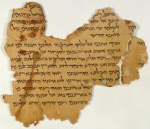 PMW 2022-005 by Kenneth L. Gentry, Jr.
PMW 2022-005 by Kenneth L. Gentry, Jr.
This is my final article in a brief series responding to the charge that preterism is anti-Semitic. The charge arises in that preterists hold that many New Testament passages prophesy the judgment of Israel. I have already shown how this charge is misdirected in several respects. But now I will show that if the charge is accurate, then Jews are themselves anti-Semtic. As odd as it may sound, this is the moral logic of our day’s politically-correct world.
The Old Testament
Revelation has John speaking strong words against apostate Judaism. He clearly writes of synagogues as a “synagogue of Satan” (Rev 2:9; 3:9; cp. Jn 8:44) and Jerusalem is called “Sodom and Egypt” (Rev 11:8), and more. The preterist approach to the book finds even more evidence of strong language against Israel. Bratcher and Hatton’s Handbook on the Revelation to John, “concentrates on exegetical information important for translator, and . . . attempts to indicate possible solutions for translational problems related to language or culture” (vii). When they get to Rev 2:9 they well note that “it is probable that these are Jews” to whom John is negatively referring. But then they write: “If translators feel that translating Jews literally will give the wrong impression to readers, it will be helpful to say ‘those who say (claim) to be God’s people, but are not’” (47). This avoids language many deem anti-Semitic.
But such strong language against Jews is no different from the way the classical prophets of the OT spoke against Israel. In the OT the prophets denounced Israel, as we see in for example in: Jer 23:1ff; Eze 34:10; Isa 56:8-11.
THE TRUTH ABOUT POSTMILLENNIALISM
By Ken Gentry
A group Bible study guide for explaining the optimistic prophetic hope for this world to be accomplished before Christ’s Second Coming. Establishes the postmillennial system in both the Old and New Testaments. Touches on key eschatological issues, such as creation, covenant, interpretive methodolgy, the great tribulation, the Book of Revelation, the Jewish Temple, and more. It presents and answers the leading objections to postmillennialism. Twelve chapters are ideal for one quarter of Sunday School.
See more study materials at: www.KennethGentry.com
Isaiah denounces Israel: “Alas, sinful nation, / People weighed down with iniquity, / Offspring of evildoers, / Sons who act corruptly! / They have abandoned the Lord, / They have despised the Holy One of Israel, / They have turned away from Him” (Isa. 1:4). He calls her leaders “rulers of Sodom” and her people “people of Gomorrah” (Isa. 1:10). Was Isaiah anti-Semitic?
In Isa 10:5-6 Assyria is sent by God against a “godless nation” (Israel). In fact, he scathingly derides the temple in his day: “he who kills an ox is like one who slays a man; / He who sacrifices a lamb is like the one who breaks a dog’s neck; / He who offers a grain offering is like one who offers swine’s blood; / He who burns incense is like the one who blesses an idol. / As they have chosen their own ways, / And their soul delights in their abominations” (Isa 66:3).
Jeremiah calls Jerusalem a harlot (like John does in Revelation!): “You are a harlot with many lovers…. You have a polluted land” (Jer 3:1, 2). “I saw that for all the adulteries of faithless Israel, I had sent her away and given her a writ of divorce, yet her treacherous sister Judah did not fear; but she went and was a harlot also” (Jer. 3:8).
Does not Israel’s own Scripture, the Tanak (our OT), warn them of God’s wrath if they turn against him (as evangelicals believe they did in rejecting Jesus and demanding his crucifixion)? Deuteronomy 28:15ff and Leviticus 26 are just two Mosaic warnings to this effect. Thus, Walker well notes that “this threat-tradition cannot be dismissed as inherently anti-Semitic. Once again Jesus was standing four-square within an accepted tradition seen throughout the canonical prophets, whereby God’s people and their institutions could be denounced in the name of Israel’s God. Indeed within the Jewish sectarianism of Jesus’ day the pronouncing of judgement upon the present regime in Jerusalem was not unusual.”
The Dead Sea Scrolls
The DSS were written by a sect of Jews who separated from Jerusalem to live in the area of Qumran sometime around 100 B.C. They wrote many documents regarding their reasons for leaving Jerusalem and the temple system. They held out hopes of the current high-priestly aristocracy being overthrown so that Jerusalem could be purified. Their writings scathingly revile Jerusalem, the temple and the inhabitants of Jerusalem. Were these devout Jews anti-Semitic? Consider their writings:
According to Iain Provan (JSNT 64 [Dec., 1996]: 92-93) in 4QpNah the Qumranians “accommodated the whole text of Nahum to Jerusalem (‘Nineveh’), indicating the way in which even texts that did not originally concern faithless Israel could be read as if they did.” There they even declared of their fellow Jews that Jerusalem was the “dwelling place” of the wicked of the nations.
Commenting on Hab 2:8, the Qumranians stated that “this concerns the last priests of Jerusalem, who shall amass money and wealth by plundering the peoples. But in the last days, their riches and booty shall be delivered in to the hands of the army of the Kittim [i.e., Romans]” (1Qp Hab 9).
The Qumranians scorned the temple priests. The high priest “robbed God and amassed the riches of the men of violence who rebelled against God, and he took the wealth of the peoples, heaping sinful iniquity upon himself” (1Qp Hab 8:11-12). 1QpHab 7 speaks of the “Wicked Priest” so that when he “ruled over Israel his heart became proud, and he forsook God, and betrayed the precepts for the sake of riches. He robbed and amassed the riches of men of violence who rebelled against God, and he took the wealth of the peoples, heaping sinful iniquity upon himself.”
They interpret Hab 2:8 thus: “this concerns the last priests of Jerusalem, who shall amass money and wealth by plundering the peoples. But in the last days, their riches and booty shall be delivered into the hands of the army of the Kittim [Romans]” (1QpHab 9). They write: “The city is Jerusalem where the Wicked Priest committed abominable deeds and defiled the temple of God. The violence done to the land: these are the cities of Judah where he robbed the poor of their possession” (1QpHab 12). In the Tosefta (t. Men. 13:22) we find the reason for the destruction of the first century Temple: “On what account did they go into exile? Because they love money and hate one another.”
The Qumranians withdrew from Jerusalem partly due to Jerusalem’s leaders being “the Spouter of Lies who led many astray that he might build his city of vanity with blood and raise a congregation on deceit” (1QpHab 10:12). The separatist Qumran community deemed Jerusalem “a place of vanity built with blood” (CDC 12:2), a “fortress of wickedness” (4QTestimonia).
Luke T. Johnson (“The New Testament’s Anti-Jewish Slander and the Conventions of Ancient Polemic,” Journal of Biblical Literature 108 [1989]: 439) writes: “Anyone who has read the Dead Sea Scrolls knows that the community that wrote them had an extreme hostility to all outsiders.” They called Jews outside of their own community “sons of the pit” (1QS 9:16; CD 6:15; 13:14), who are ruled by the angel of darkness (1Q3: 19-21; 5:2, 10), and are “the ungodly of the covenant” (1QM 1:2). Of those Jews they write in 1QS 2:4-10: “Be cursed of all your guilty wickedness! May he deliver you up to torture at the hands of all the wreakers of revenge.”
Thus, the Qumran community deemed Jerusalem as defiled and worthy of divine curse (CDC 1:3; 4:18; 5:6; 6:16; 12:1-2), as did much of the apocalyptic literature beginning in 200 B.C., as we see in 1 Enoch 83-89; The Apocalypse of Weeks; T. Levi 17:10; and Jubilees 23:21.
Conclusion
In the final analysis, if we believe that the New Testament is the inspired word of God…. And if we believe that it records actual historical events and statements…. Then we have to interpret it according to its original intent. Though it is true that some racists have used the statements of the New Testament to justify ill-treatment of Jews, this is an abuse of this historical document. These people should be rebutted on moral and theological grounds, not by throwing out the NT. Nor by suppressing the meaning of what John wrote in Revelation.
Kenneth L. Gentry Jr.'s Blog
- Kenneth L. Gentry Jr.'s profile
- 85 followers



